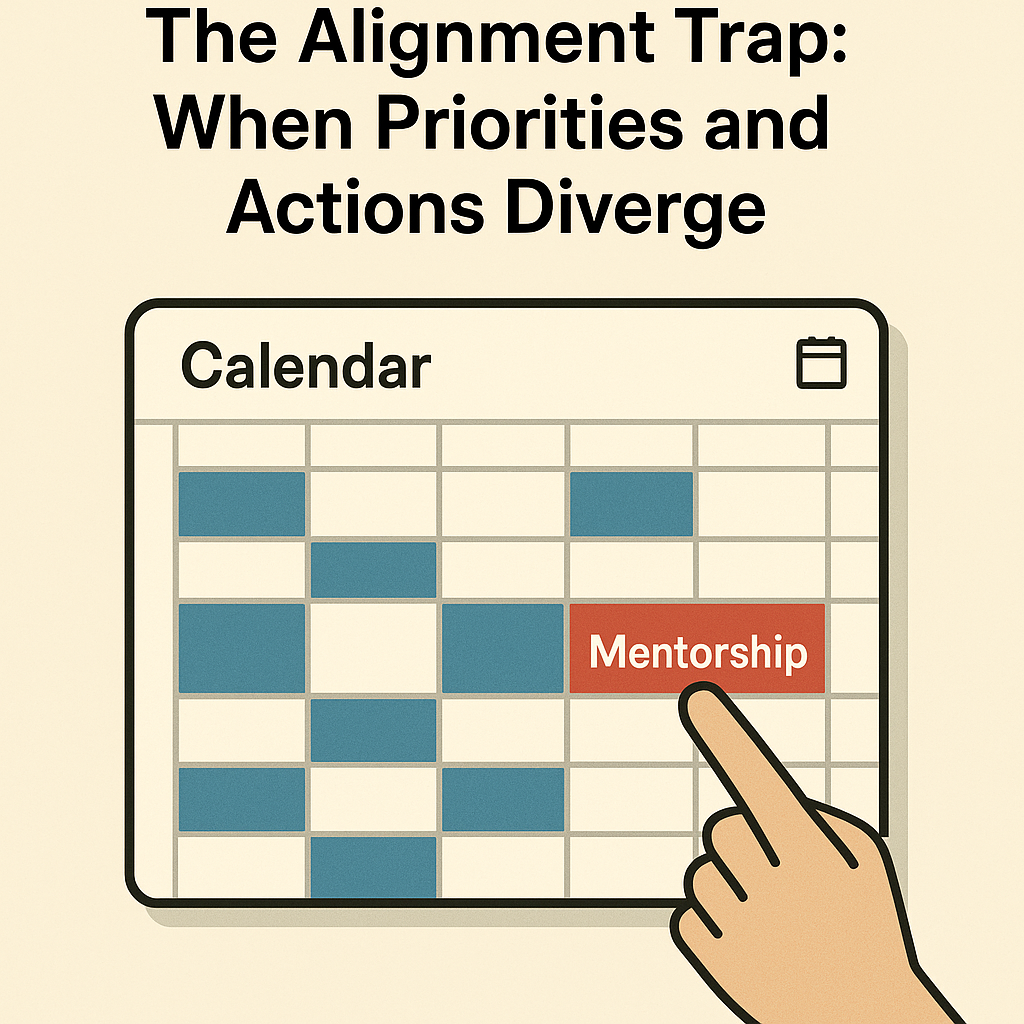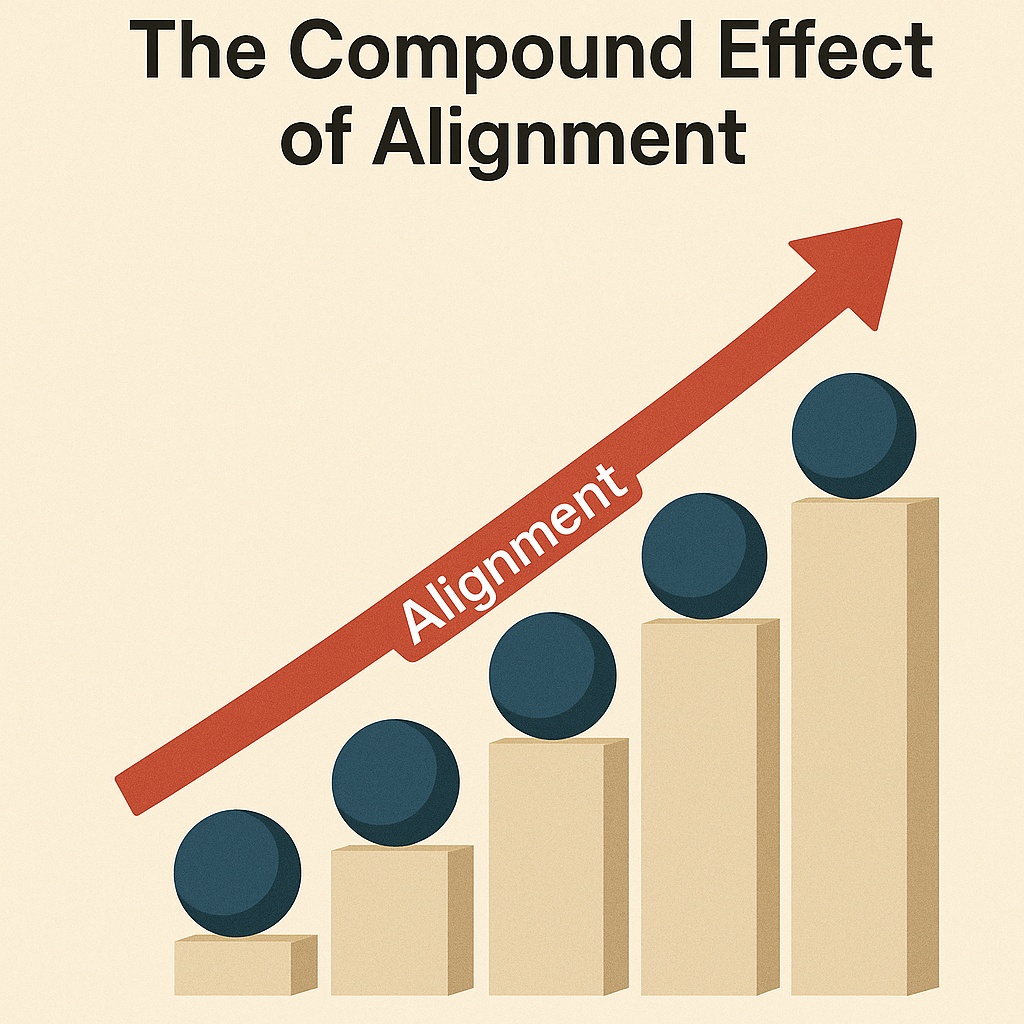Welcome to the 70th edition of #theFutureReadyAdvisor Newsletter!
Subscribe & join the conversation. Share comments and feedback.
Most leaders can tell you their priorities in 30 seconds. Ask them where they spent last Tuesday, and the story changes.
A senior partner at a large wealth management firm once told me his top priority was “developing the next generation of advisors.” He spoke passionately about mentorship, knowledge transfer, and building a sustainable practice for the future. When I asked him to walk me through his calendar from the previous week, we discovered something telling: he’d spent 32 hours in client meetings, 4 hours on compliance issues, 2 hours in partner meetings—and exactly zero minutes with junior advisors.
This wasn’t hypocrisy. It was the alignment trap—the dangerous gap between what we say matters most and what our actions actually prioritize. Like a GPS that knows the destination but can’t find the route, we often have clarity about our goals but remain lost when it comes to aligning our daily choices with our stated priorities.
The cost of this misalignment isn’t just inefficiency—it’s the slow erosion of the very outcomes we claim to value most.

The Day Southwest Airlines Almost Lost Its Way
In the early 2000s, Southwest Airlines faced what seemed like an existential threat. After decades of growth built on their low-cost, no-frills model, competitors were matching their prices while offering premium amenities. Internal pressure mounted to add first-class sections, premium lounges, and complex fare structures. The airline industry consensus was clear: evolve or die.
But Southwest’s leadership did something counterintuitive. Instead of chasing every new revenue opportunity, they returned to a fundamental question: What are we actually trying to accomplish? Their answer was simple but profound: democratize air travel by being the low-cost provider that connects people to what matters most.
This clarity became their alignment filter. Every decision—from route planning to aircraft purchases to employee training—had to pass a single test: Does this advance our mission of being the reliable, affordable option for everyday travelers?
When the opportunity arose to add premium services, they said no. When competitors tried to undercut them on specific routes, they focused on operational efficiency rather than reactive pricing. When the 2008 financial crisis hit the airline industry, Southwest’s aligned priorities meant they had the financial reserves and operational flexibility to not only survive but to acquire struggling competitors.
The result? While traditional carriers struggled with complex business models and inconsistent customer experiences, Southwest remained profitable for 44 consecutive years—a streak unmatched in the airline industry.
For financial advisors and business leaders, Southwest’s story illustrates a critical truth: alignment isn’t about perfect planning—it’s about consistent decision-making that reinforces your core priorities, especially when external pressures push you in different directions.
The Anatomy of Misalignment
Through my work with leadership teams across industries, I’ve identified three patterns that create the alignment trap:
Priority Inflation: Most organizations struggle with priority overload—when teams have too many competing priorities, their productivity and goal achievement suffer significantly. Research shows that priority overload is the most common dysfunction holding teams back, leading to burnout, diminished engagement, and a substantial drop in performance. As highlighted in a 2024 report from i4cp and recent Gallup analysis, focusing on fewer, high-value objectives dramatically improves a team’s likelihood of success and reduces the risks associated with burnout and inefficient work practices.
A senior executive I know well recently shared his firm’s transformation story with me. His financial services company had listed 12 “strategic priorities” for the year, from client retention to technology upgrades to market expansion to regulatory compliance. When they mapped where the leadership team actually spent their time and resources, they discovered they were making minimal progress on any initiative because their attention was scattered across too many competing demands. The firm was consistently failing to meet quarterly objectives, client satisfaction scores were declining, and top talent was leaving for competitors with clearer strategic direction.
Then a new CEO arrived. Within her first 90 days, she implemented what she called “ruthless prioritization”—identifying the three non-negotiable priorities that would determine the firm’s success and parking everything else. She created simple “alignment filters”: questions the leadership team could ask before committing time or resources to any initiative. The results flowed from there: focused execution, clearer accountability, improved client outcomes, and measurable progress on what actually mattered.
The Urgency Override: Even when priorities are clear, urgent demands often override important ones. Email responses feel more pressing than strategic planning. Client crises overshadow team development. Regulatory compliance takes precedence over innovation.
This isn’t a personal failing—it’s human psychology. Our brains are wired to respond to immediate stimuli more strongly than abstract future benefits. The most successful leaders I work with don’t fight this tendency; they design systems that make important activities feel urgent too.
Measurement Misalignment: Perhaps the most insidious form of misalignment occurs when organizations measure one thing but prioritize another. A wealth management firm might say client relationships are their top priority while measuring advisors primarily on assets under management. A corporation might emphasize innovation while rewarding quarterly revenue above all else.
As management guru Peter Drucker observed, “What gets measured gets managed.” If your measurement systems don’t reflect your stated priorities, your actions will inevitably drift toward what you track rather than what you claim to value.
Building Your Alignment System
Achieving true alignment between priorities and actions requires more than good intentions—it demands systematic approaches that make your priorities visible and actionable every day:
1. The Priority Audit: Start with brutal honesty about where your time and resources actually go. For one week, track every hour and every dollar spent. Then compare this reality to your stated priorities. The gaps will be illuminating.
For advisory practices: Does your time allocation match your stated priorities around client service, business development, and team growth? Are you investing resources in activities that directly support your core value proposition?
For corporate leaders: Is your calendar aligned with your strategic initiatives? Are your budget allocations consistent with your stated organizational priorities?
2. Create Decision Filters: Southwest Airlines uses their mission as a decision filter. You need your own version—simple questions that help you evaluate opportunities and demands against your core priorities.
Effective filters are:
- Simple enough to remember under pressure
- Specific enough to guide real decisions
- Aligned with your most important outcomes
For example, an advisor focused on building long-term client relationships might ask: “Does this activity directly enhance my ability to serve existing clients or attract ideal new ones?” If the answer is no, it’s probably a distraction.
3. Build Accountability Systems: Alignment requires ongoing course correction, not just initial intention-setting. The most effective leaders create systems that regularly surface misalignment before it becomes problematic.
This might include weekly priority reviews, monthly alignment check-ins with your team, or quarterly assessments of how your actual resource allocation compares to your stated priorities. The key is making misalignment visible early enough to adjust course.
4. Design Your Environment for Success: Rather than relying on willpower to maintain alignment, successful leaders design their environment to make aligned behavior easier and misaligned behavior harder.
This could mean blocking calendar time for your most important priorities, creating physical spaces that support your key activities, or establishing team structures that naturally reinforce your organizational priorities.
The Compound Effect of Alignment
Here’s what I’ve learned from working with organizations that achieve true alignment: small, consistent actions in service of clear priorities create compound effects that are impossible to achieve through sporadic effort or scattered focus.
The advisory firms that build truly sustainable practices don’t just happen to get client retention right—they align their entire operation around client success. Their onboarding processes, communication rhythms, investment philosophy, and team structure all reinforce the same core priority.
The corporate leaders who drive lasting transformation don’t just talk about change—they align their hiring decisions, budget allocations, meeting agendas, and recognition systems around their strategic priorities.
This kind of alignment doesn’t happen by accident. It requires intentional design and consistent maintenance. But when you achieve it, the results are remarkable: decisions become clearer, execution becomes faster, and outcomes become more predictable.
The alignment trap is seductive because good intentions feel like progress. But intentions without aligned actions are just elaborate forms of procrastination. The organizations and leaders who thrive in uncertainty aren’t those with the best plans—they’re those whose daily actions consistently reinforce their most important priorities.

Key Takeaways for Building Alignment:
- Audit ruthlessly: Compare your time and resource allocation to your stated priorities—the gaps reveal your real priorities
- Filter decisions: Create simple questions that help you evaluate opportunities against your core objectives
- Measure what matters: Ensure your metrics and rewards reinforce your most important priorities, not just your most measurable ones
- Design for success: Structure your environment to make aligned behavior easier and misaligned behavior harder
The question isn’t whether you have good priorities—most leaders do. The question is whether your daily choices actually serve those priorities or work against them. True alignment isn’t a destination you reach once; it’s a discipline you practice daily.
Alignment is the “A” in my CASE Foundation for thriving in uncertainty—because without it, even the best strategies become scattered effort. When your actions consistently serve your priorities, everything else becomes clearer.
If aligning your actions with your priorities feels like an uphill battle, you’re not alone. I created The Uncertainty Edge to help leaders master this alignment, even when the path forward isn’t clear.
📥 Get the free guide: The Uncertainty Edge — proven frameworks for aligning decisions with what matters most.
The partner I mentioned at the beginning? He’s now one of the most effective mentors in his firm. The difference wasn’t changing his priorities—it was finally aligning his calendar with them. Some of the best leaders I know are those who learned to close the gap between what they say matters and what they actually do. The alignment trap catches everyone eventually, but only some choose to escape it.
When you are ready, direct message me and I can help you with
- Speaking Engagements & Workshops designed for your team and clients
- Tailored, high-impact Consulting and Coaching Services for your practice
Check out my podcast and other resources at www.samsivarajan.com


